All the patterns say “Square Your Fabric” but what does it mean!? Often when the fabric has been cut in a shop, it arrives less than straight. Before you can swiftly use your rotary cutter you need to prepare a straight edge to work with.
My favorite tools for cutting fabric can be found here.
This piece of fabric had some extra funky folds in it, and looked like they had been on the bolt that way for a long time, which makes it a great example!
Check out my video on using a rotary cutter safely, and other cutting tips!
Squaring Fabric
1. First, you need to press your fabric to eliminate any creases or folds in the fabric.
2. Fold your fabric, selvage to selvage. In the photo above there is a bubble in the fold at the bottom.
3. Adjust your selvage edges, left to right until the fold lays flat. I do this with my fingertips, and scoot the edges one way or the other until it is laying flat.
4. Lay it down on the cutting mat and get ready to cut. Notice that the cut edges are NOT together (that’s what we need to fix!).
5. I’m using home decor fabric that is 60″ wide which means I needed to fold the fabric a second time. Usually, this is not the case unless your cutting mat or ruler is shorter than 24″.
6. Next, line up your folded edge along a straight line at the bottom of your cutting mat.
7. Check the depth that is needed to cut to have a continuous straight edge.
8. Bring on the ruler, and cut. Your fabric should be lined up straight on the bottom folded edge, and your ruler should be matched up with the grid lines.
9. Now you should have a nice edge to begin cutting your quilt pieces! If you are cutting more than a few strips, you will want to re-square your fabric often, especially if you feel your ruler slip. I typically re-square with every cutting mat width.
Fabric Details – Denyse Schmidt’s County Fair has been used in this tutorial.
I hope that helps you as you are squaring fabric!
Amy
Check out my Dart quilt, to put your scrap bin into your next quilt!

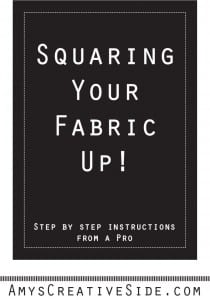
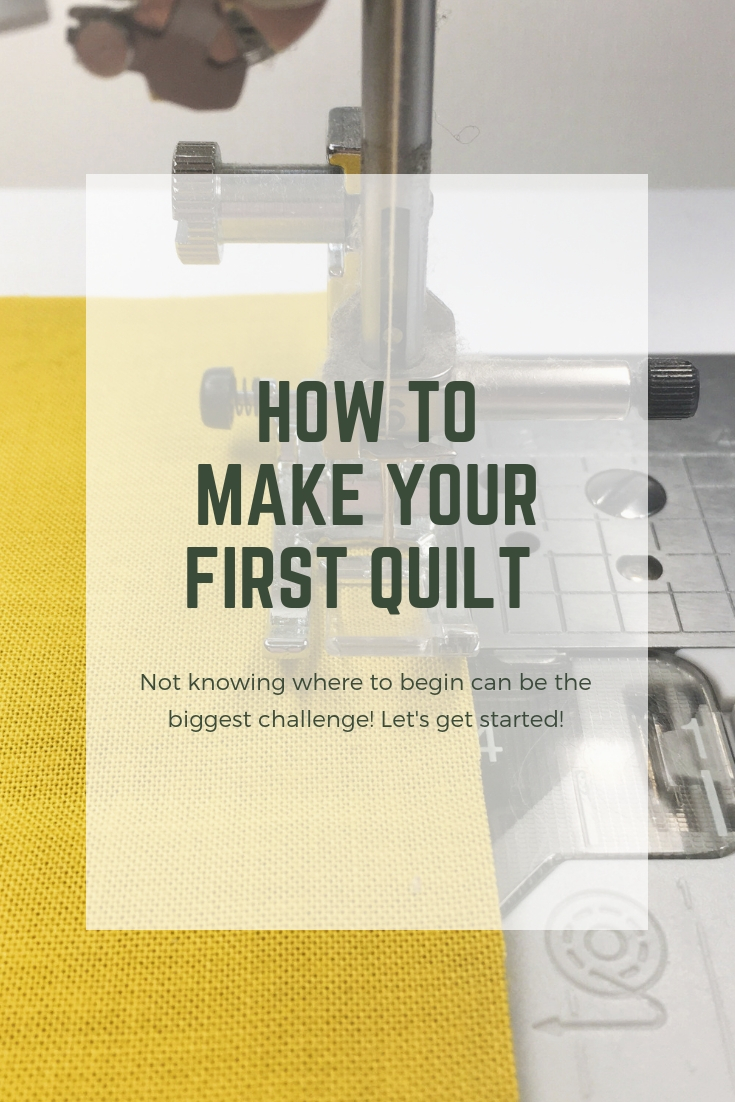

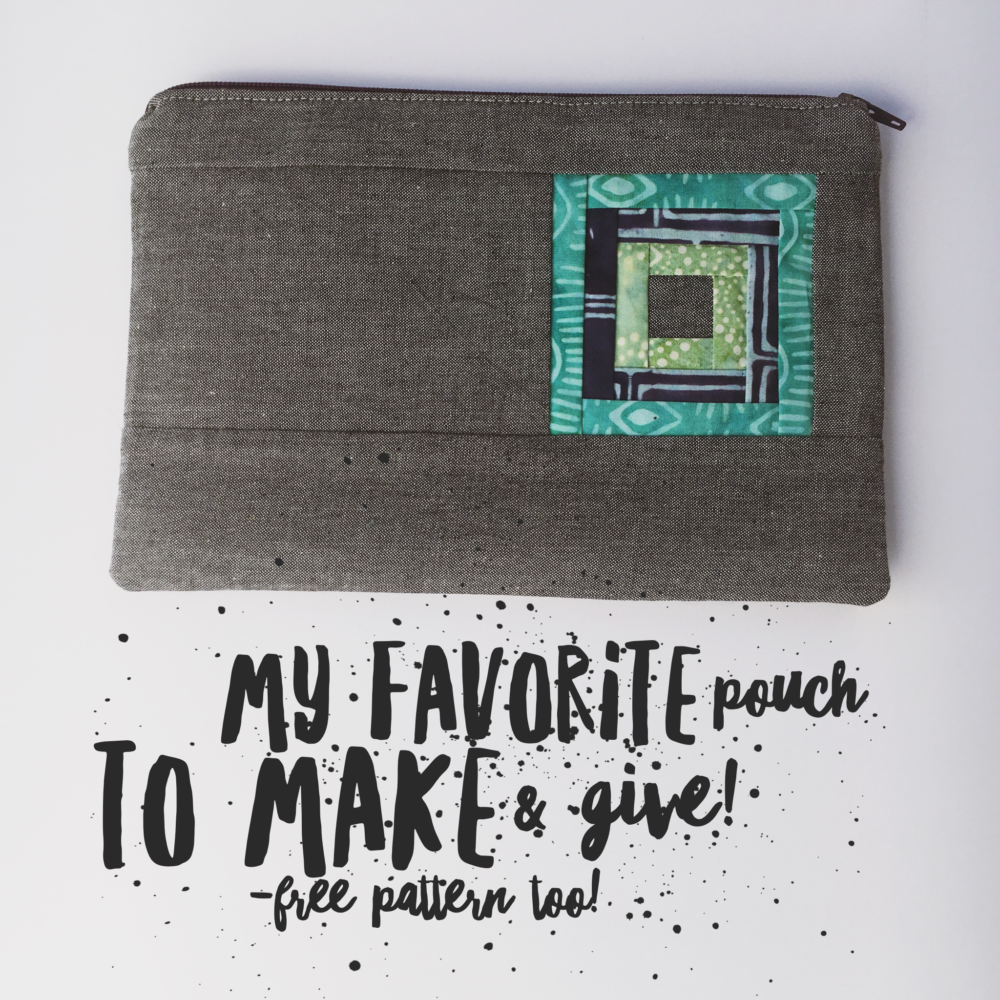
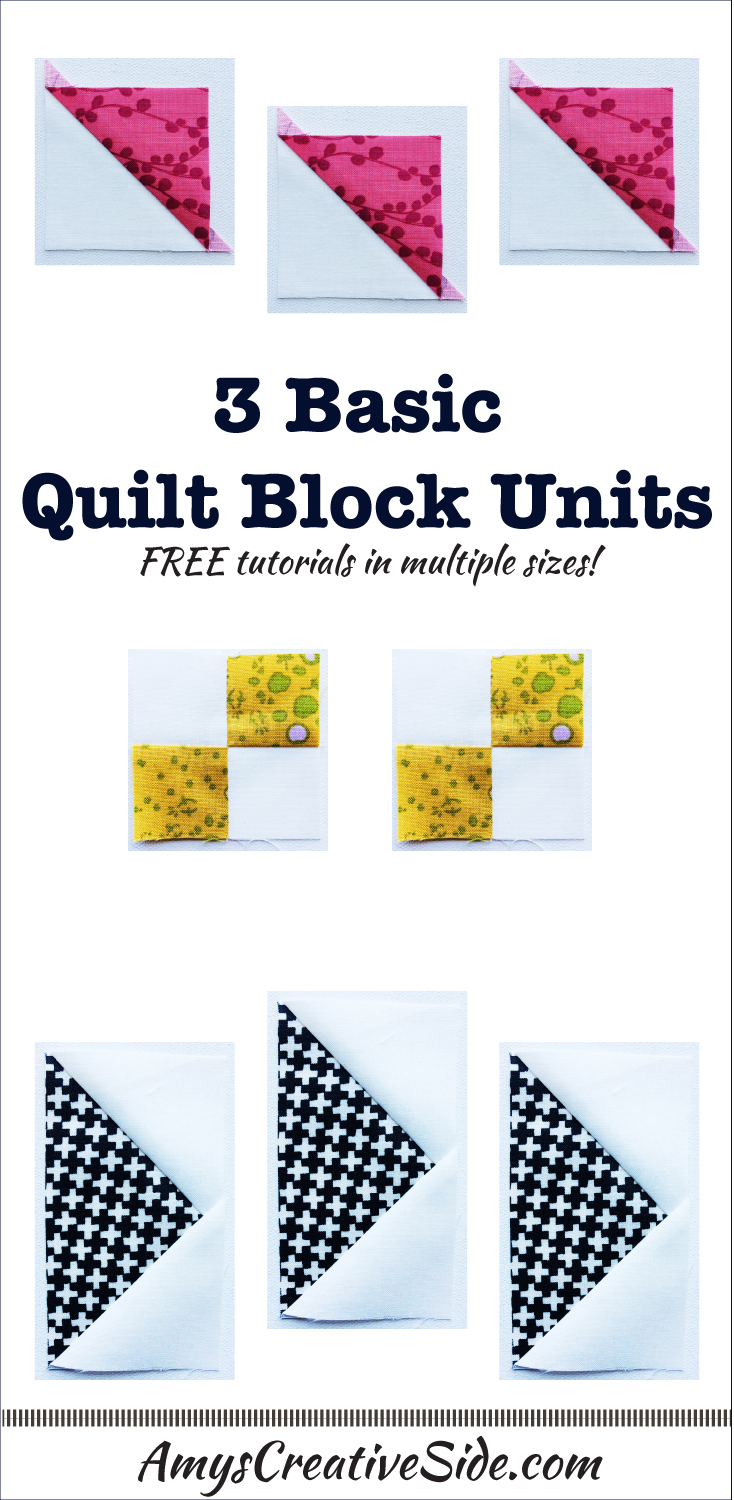
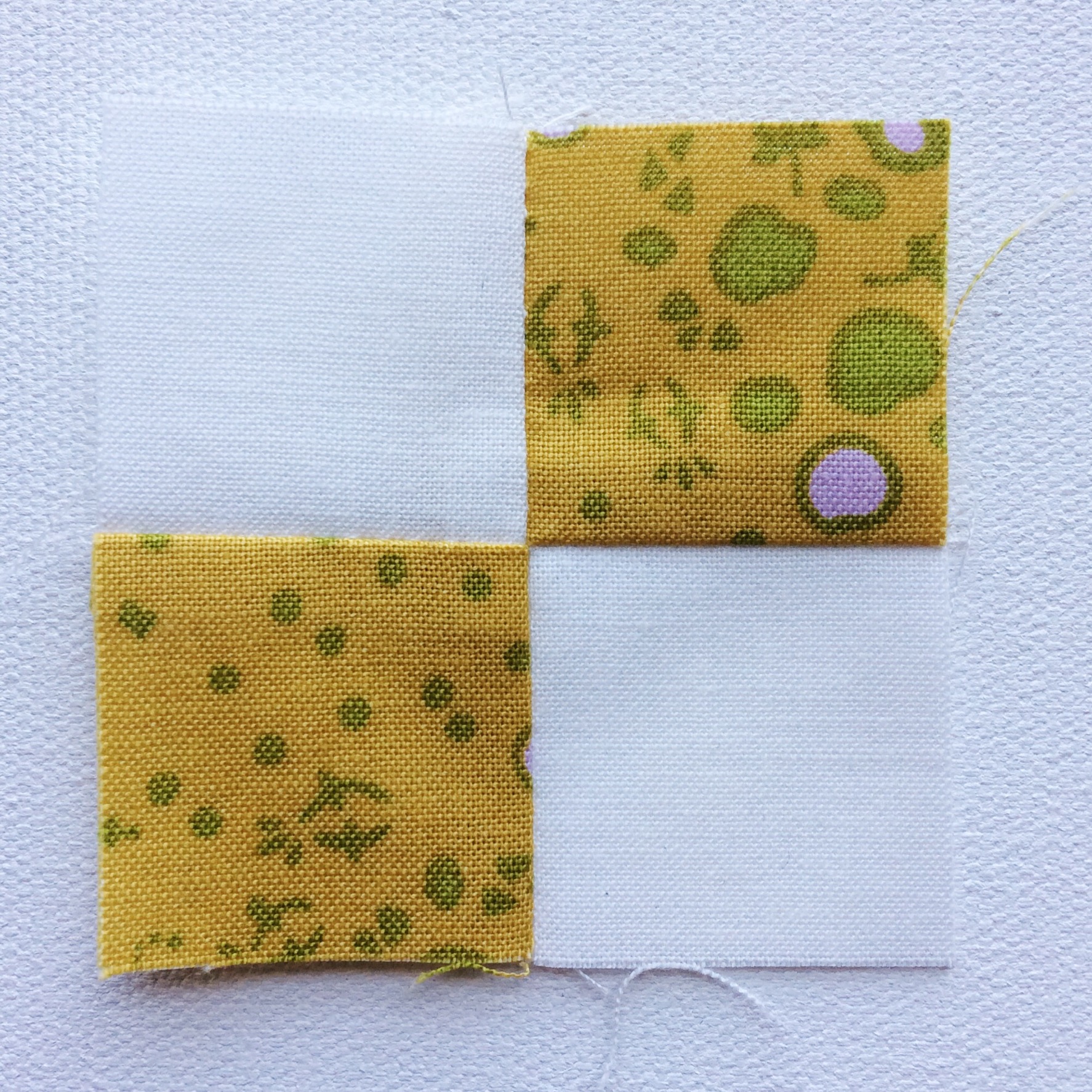
I am a complete novice in sewing so this may be a silly question but in the second to last picture, the left side isn't even either so did you do the same thing to the other side and make that even as well? Or is there a reason that it doesn't matter?
Love the fabric by the way! :)
Jacquie – If I'm cutting strips or squares I usually don't! There's no need to square the other side unless you are cutting a big square, just work with the one straight edge.
Hope this helps!
Amy
Great tutorial! Thanks for sharing!
Thanks so much for your quick response! That makes complete sense :)
I am in the middle of my first ever sewing project and already have dozens more lined up that I want to try. Quick/useful tips like this are just what I'm looking for :)
Thanks again for this great tutorial!
Just read your tutorial,I was wondering,should you wash the fabric first?
Many thanks
Sue
I've never done the double-fold technique, before, but I don't use the extra-wide widths.
I single fold, selvage-to-selvage, and align a ruler line to the fold, then cut to square up. Always keep in mind that your fabric is only squared up for the distance that your ruler is. So, if you use a 6" ruler, you have to re-square every 6".
Sue – Pre-washing fabric is a matter of personal choice. I opt not to, but there are a few reasons to pre-wash, like shrinkage and sizing allergies. I believe shrinking varies with the quality of cottons, and to avoid allergic reactions, I wash my quilts as soon as they are finished! If I am sewing a garment – I always pre-wash.
Looks great! It took me so long to figure out how to do that, and for some reason it kind of scared me too. What I like to do when I'm done is unfold it and lay my ruler along the cut where I'd had it folded to make sure it really, really is straight. :D
Great Demo! I learned this in HomeEc back in 1960. I don't think they even teach this anymore. Good for you for taking the time to do this.
ttfn :) Yuki Nakamoto
No. They don’t teach sewing or home economics,.. that would be sexist nowadays. :(
Thanks for replying so promptly.I am new to your blog and would like to say how much I am enjoying it.
Sue
Ditto to the comments about continually resquaring.
I posted a video of this in my quilt along tutorials.
Ditto to the comments about continually resquaring.
I posted a video of this in my quilt along tutorials.
Ditto to the comments about continually resquaring.
I posted a video of this in my quilt along tutorials.
Great tutorial. It's so much easier when you have pictures!
Great tutorial Amy, would only reiterate the comments to keep checking and re-squaring as you cut.
From a newbie quilter, thanks so much.
Big help.
I sort of knew this – but it's good to see it laid out in pictures! Thanks for sharing!
This is exactly how I do it, too. But it's so frustrating to see inches of beautiful, expensive fabric wasted. At my LQS (and even the local chain stores), if you ask for 1/2 yard, they cut 18" and not one mm more. Once it's squared up, I rarely have more than 16" of usable space. Very frustrating when a pattern calls for 18" strips or 3 – 6" blocks, etc. Any tips on how to handle this?? Do you just buy more?? A few more inches per fabric x 10+ fabrics per quilt really adds up quickly.
Thanks for the great tip! I love your blog.
thanks for doing this!! i get asked this all the time!
That is what I usually do myself. Since I buy white cotton in bolts, I find that tearing it off instead of cutting give a more or less even edge.
I have that same fabric–in orange! It's beautiful quality fabric too. That is one thing that helps with the "offset" of the edges and waste. Thanks for spelling it out so well.
Wendy: I ALWAYS buy more fabric than the pattern calls for. I also wash my fabric before I cut. By buying more fabric, I don't have to worry about shrinkage after I've sewn my project. I also remove the sizing and other chemicals that make me sneeze. Buying extra removes the stress of not having enough, allows for cutting mistakes (which I'm sure NEVER happens to anyone but me), allows me to have more of that fabric if I fall in love with it while I'm working with it (which is always one week after the shop sold the last of that fabric), and builds up my stash of scraps for that scrap quilt that I'll be making soon! I even have a plan! Sure, extra fabric can add up, but stress should not be a part of our sewing or quilting projects.
Denny — That's a great perspective!! And you're right, sometimes it's cheaper to buy extra for the peace of mind :)
Thanks for stepping up Denny! Buying extra for the inevitable misguided cut is a great plan. Happy quilting!
Thanks. That's a great tutorial.
Thank you for sharing this!! I have been needed to see this again! I just started quilting and am still learning everything!! Thanks again!
Hi
Basics Tutorial-Squaring Fabric.
I Found this very informative for the beginners who want to try quilting.
Thanks for this awesome tutorial. My Grandmother brought me up quilting, but I rarely got to see the technical end of things, being a small child, and later a disinterested teen. This has been most helpful! Your quilts are wonderful, by the way :)
Thank you so much for this post. I’ve found that I need very explicit step by step photos to learn a new technique and your post gave me the information I need to be able to cut straight strips with my rotary cutter. Now to go try cutting straight strips without the dip!
Great tutorial and comments. Now how do you square up the pieced blocks? I am new to quilting and need pointers. Thanks.
How do you square up a large piece of fleece that the selvages have been cut off?
How do you square up a large piece of fleece that the selvages have been cut off?
I’m sure there are many that will find this quite helpful are you are to be applauded for that. I was kind of surprised that the tutorial did not consider that the reason many fabrics are not squared to begin with is that the threads are warped off the “true” when the bolt is wound at the factory, meaning they are no longer at right angles to each other. The threads are supposed to be at right angles to each other on the warp (length of the fabric)and weft (runs back and forth from selvedge to slevedge). If a piece of yardage has been pulled on one corner during the winding of the bolt, (not wound straight) the grain is no long at right angles to itself. Squaring in the manner you give will give perfectly square looking pieces, but they may be off-kilter after washing and drying if they return to the “true” right angles inherent in the grain after they get wet.
This is not at all meant to be critical, just informative. I am just old school, but very willing to learn new tricks too, or I would not be reading so many Pinterest links!
To find the true grain, unravel threads at one cut end until you get a complete thread running across the cut end, not a number of threads unraveling at different spots. Trim the ends of the warp threads that are left sticking out.Take the fabric and place on any large grid (even a table will work) and see then if that cut edge and the selvedge are at right angles to each other. If not, then one takes the fabric in hand, opening it to the full 90″ width, then stretching it at a 45 degree angle across the grain to get it back at right angles. One works from one corner down the fabric, continually stretching across a 45 degree angle, working down about 2″ to 4 ” at a time. It’s easier to show than tell anyone and I don’t have a blog and don’t post videos on You Tube. Anyway, you keep working the fabric takes maybe 5 minutes at the most) and put back on the grid or table. Once the fabric has a true right angle and will match up on a cutting grid or edges of a table properly, you proceed with the method you posted.
The whole point is that fabric sometimes gets twisted or pulled off grain at the factory. I learned this when sewing garments since fabric will not hang right if the fabric is not true to grain when cut. One of the clues that the grain may be off is that fact that there were folds in the original bolt and/or the cutting lines did not match when you first folded it. Many bolts are just fine, but ever so often, one must true the grain on a piece.
I always wash my washable fabrics before even storing them, and that will solve a lot of grain issues in advance of use. Before I use fabric on a project, I always “pull” threads from the cut end to check the grain, then use your method if needed due to a poor job of cutting by store employees. I must say I always buy extra fabric!
Thank you Patty! I sew mostly garments and this comment was very helpful. I am making a copy to keep and use and also to share with my sewing circle.
I purchased a yard of fabric from an online seller. I want to square it up before making a baby quilt. I found the selvage for one side, but there isn’t one on the opposite side. How can I square it up? Thanks for any tips and help you can give me!
I was trained as a Home Economist in the 1950s and 1960s. We were trained to have two people pull the fabric at opposite ends until fabric was straight. Your method still leaves fabric grain not straight. Your method may work for small projects but will have garment sagging at some places. I hope this helps garment sewers. I enjoy your posts.
Alice